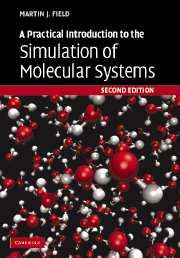Book contents
- Frontmatter
- Contents
- Preface to the first edition
- Preface to the second edition
- 1 Preliminaries
- 2 Chemical models and representations
- 3 Coordinates and coordinate manipulations
- 4 Quantum chemical models
- 5 Molecular mechanics
- 6 Hybrid potentials
- 7 Finding stationary points and reaction paths on potential energy surfaces
- 8 Normal mode analysis
- 9 Molecular dynamics simulations I
- 10 More on non-bonding interactions
- 11 Molecular dynamics simulations II
- 12 Monte Carlo simulations
- Appendix 1 The pDynamo library
- Appendix 2 Mathematical appendix
- Appendix 3 Solvent boxes and solvated molecules
- Bibliography
- Author index
- Subject index
2 - Chemical models and representations
Published online by Cambridge University Press: 03 December 2009
- Frontmatter
- Contents
- Preface to the first edition
- Preface to the second edition
- 1 Preliminaries
- 2 Chemical models and representations
- 3 Coordinates and coordinate manipulations
- 4 Quantum chemical models
- 5 Molecular mechanics
- 6 Hybrid potentials
- 7 Finding stationary points and reaction paths on potential energy surfaces
- 8 Normal mode analysis
- 9 Molecular dynamics simulations I
- 10 More on non-bonding interactions
- 11 Molecular dynamics simulations II
- 12 Monte Carlo simulations
- Appendix 1 The pDynamo library
- Appendix 2 Mathematical appendix
- Appendix 3 Solvent boxes and solvated molecules
- Bibliography
- Author index
- Subject index
Summary
Introduction
Models and representations are crucial in all areas of science. They are employed whenever one thinks about an object or a phenomenon and whenever one wants to interpret or to predict how it is going to behave. Models need not be unique. In fact, it is normal to have multiple representations of varying complexity and to choose the one that is most appropriate given the circumstances.
The same is true when thinking about chemical and molecular systems. Representations encompass the traditional chemical ones that employ atoms and bonds, and also span the range from the very fundamental, in which a molecule is considered as a collection of nuclei and electrons, through to the highly abstract, in which a molecule is treated as a chemical graph. Several of these are illustrated in Figure 2.1.
The purpose of this chapter is twofold. First, we introduce the way in which pDynamo represents and manipulates molecular systems. Of course, we can only start to discuss these topics here as pDynamo has a diversity of approaches that will take the rest of the book to explain. Second, we describe several common molecular representations that are used in modeling and simulation studies and show how pDynamo can transform between them.
The System class
System is the central class of the pDynamo program and it will be used directly or indirectly in most of the examples in this book. Its purpose is to gather together the data that are required to represent, to model and to simulate a molecular system. The fundamental data in a system are the sequence of atoms that it contains.
Information
- Type
- Chapter
- Information
- Publisher: Cambridge University PressPrint publication year: 2007
